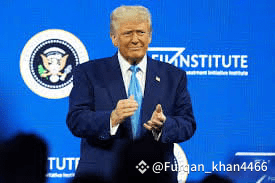
In a recent statement that has generated buzz across financial and political circles, former President Donald Trump proposed a novel idea: allocating 20% of the government’s savings in Dogecoin (DOGE) to American citizens. This suggestion, made during a public appearance, raises intriguing questions about the intersection of cryptocurrency, government policy, and individual financial empowerment.
Understanding Dogecoin
Dogecoin, which began as a meme-inspired cryptocurrency in 2013, has garnered a significant following and a notably volatile market presence. Originally created as a lighthearted alternative to Bitcoin, it has transitioned into a more serious investment vehicle, with a dedicated community and increasing acceptance among merchants. Its rise to prominence has been fueled by endorsements from high-profile figures and a growing interest in digital currencies.
The Proposal
Trump’s proposal brings DOGE into the realm of governmental financial strategy. He suggested that, by utilizing the government’s current holdings or future potential gains from DOGE investments, a portion of these funds could be distributed to American citizens. The ethos behind this idea aligns with broader discussions about wealth redistribution and economic support, particularly in the wake of the economic challenges faced during and after the COVID-19 pandemic.
Key points surrounding this proposal include:
Economic Relief: The allocation of funds from DOGE savings could provide a direct financial benefit to citizens, especially those struggling to recover from economic setbacks. In an era of rising inflation and wage stagnation, additional financial support could be a welcome relief for many households.
Validation of Cryptocurrency: By suggesting that government funds could be funneled through a cryptocurrency, Trump’s statement may signal a shift toward greater acceptance of digital currencies as legitimate financial instruments. This could pave the way for future policies that embrace blockchain technology and decentralized finance.
Public Skepticism: While the idea may appeal to some, it also faces skepticism. Critics may question the feasibility of such a proposal, including the government’s current holdings in DOGE and the implications of using a highly volatile asset for financial distribution. There are concerns over how the program would be administered and the effectiveness of relying on cryptocurrency as a stable source of funding.
Market Reaction
Following Trump’s announcement, the price of Dogecoin exhibited fluctuations typical of news-driven events. Investors and speculators are likely reacting to both the potential endorsement of the cryptocurrency and the volatility that can accompany any political statement regarding financial assets. In the broader context of cryptocurrency markets, such news can lead to increased trading and speculative behavior.
Implications for Future Policies
Trump’s suggestion opens up a broader dialogue about the role of cryptocurrencies in future governmental financial decisions. As digital currencies gain traction globally, there is a growing need for clear regulations and frameworks that address their use in public finance. Policymakers must consider how to manage the risks associated with cryptocurrency volatility while exploring innovative ways to leverage these assets for public good.
Conclusion
While President Trump’s idea of allocating 20% of the government’s DOGE savings to American citizens is still in the early stages of conversation, it reflects a growing trend of integrating cryptocurrency into mainstream financial discussions. As the world continues to grapple with economic disparities and seeks new solutions, Trump’s proposal could be a stepping stone toward more innovative economic policies. However, its practicality and the broader implications for the cryptocurrency market will need to be carefully examined as discussions unfold.
In an ever-changing financial landscape, one thing remains clear: the dialogue surrounding cryptocurrency is far from over, and ideas like these could shape the future of economics and governance in unexpected ways.
